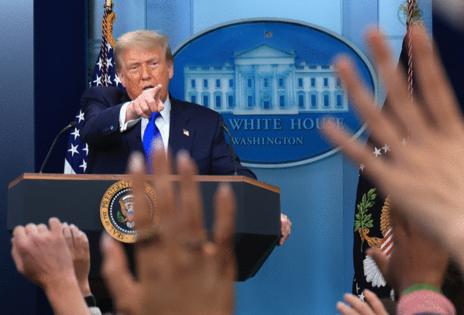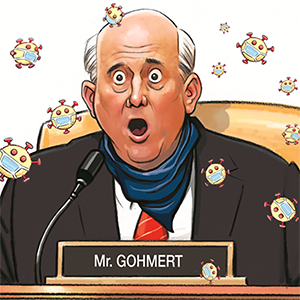Supreme Court pushes right in term stocked with Trump cases
Published in News & Features
WASHINGTON — The Supreme Court’s conservative majority continued to march American law toward the right during its term that ended last week, in a steady stream of 6-3 decisions in major cases along with a flood of emergency appeals sparked by the Trump administration.
The two dynamics played out over the past months in decisions such as those that upheld Republican-backed actions to ban gender-affirming care and exclude Planned Parenthood from federal funds, and orders that sided with President Donald Trump’s policies on many moves of his that lower court judges had halted.
The court’s decisions in contentious cases often came down to three votes — Chief Justice John G. Roberts Jr. and Justices Amy Coney Barrett and Brett M. Kavanaugh — that determined whether the court’s most conservative justices or its Democratic appointees would prevail.
“The middle three are in the majority an overwhelming majority of the time,” said Kevin King, a partner at Covington & Burling law firm who focuses on appellate and administrative and constitutional law matters. “They have the swing votes, they have the control, they are exercising a significant amount of control over the court’s direction.”
Barrett wrote the majority decision for the 6-3 decision curtailing nationwide injunctions against Trump’s policies. Roberts wrote the 6-3 decision upholding a Tennessee state law banning gender-affirming care for minors. And Kavanaugh wrote a decision reining in environmental reviews under the National Environmental Policy Act where the three justices on the liberal wing concurred only in the judgment.
King said that across multiple cases, he’s seen “political accountability as a major theme” of the current court, with the justices choosing and deciding cases on the margins of where experts and agencies can act apart from elected or appointed officials.
“The powers and scope of administrative agencies continue to be front and center on the court’s docket and continue to be the center of the court’s attention,” King said.
King pointed to the decision upholding the 2010 health care law’s preventative care coverage mandate because members of the review board for the mandate were removable by the secretary of Health and Human Services, as well as the decision upholding a Federal Communications Commission program because the Commission retained control over the program even though another entity managed it.
In both of those cases, the three justices in the middle joined the three justices on the liberal wing of the court to form the 6-3 majority.
Cecilia Wang, the national legal director of the American Civil Liberties Union, said the court’s conservative majority has ruled as a bloc in high-profile cases, including in a decision that a Texas law requiring pornography websites verify the ages of their users did not violate the First Amendment rights of adults in the state.
“In the high-profile civil rights and civil liberties cases decided by the court this term, we saw really sharp right turns by a 6-3 majority of the court,” Wang said.
Wang said there were several lower-profile cases where the justices ruled in favor of civil rights, such as allowing an Americans with Disabilities Act lawsuit against state officials and allowing a family to move forward with a lawsuit against the FBI for a wrong-house raid.
The high-profile decisions have frequently left the court’s Democratic appointees in dissenting positions, warning both in public and in their writings about the rule of law and the ability of citizens to use the courts when the government violates their rights.
Justice Sonia Sotomayor criticized the majority decision in a dissenting opinion in the birthright citizenship nationwide injunction case.
“The rule of law is not a given in this Nation, nor any other. It is a precept of our democracy that will endure only if those brave enough in every branch fight for its survival,” Sotomayor wrote in her dissent.
Emergency docket and Trump
In the first few months of Trump’s second term, a flood of litigation has dealt with executive actions out of the White House, with more than a dozen fast-paced cases landing at the Supreme Court.
Those landed on the court’s “emergency docket,” where cases are decided with fewer formalized procedures and frequently on a shorter time frame. The Supreme Court heard oral arguments in two emergency docket cases this term. One, on the constitutionality of a federal law forcing the sale or ban of the social media giant TikTok, was heard just before Trump again took office. The other was on the constitutionality of nationwide injunctions against Trump’s order restricting birthright citizenship.
Wang said the justices are increasingly shaping American law through those emergency cases. “The emergency docket, in many ways, is eclipsing the merits docket in importance,” Wang said.
Across most of those cases, the justices have ruled in favor of the Trump administration: allowing the firing of federal officials, the freezing of funds and the revoking of a parole status for more than 500,000 immigrants in the country.
But the court did throw a speed bump in administration plans, in a decision that requires the government to give migrants it seeks to deport under the Alien Enemies Act an opportunity to contest their removals at the court that has jurisdiction over where they are held.
In a concurrence in the nationwide injunction case, Kavanaugh wrote that he sees the Supreme Court as the arbiter of whether executive policies should be paused, possibly for years at a time, while a legal case plays out.
“The answer typically will be this Court, as has been the case both traditionally and recently,” Kavanaugh wrote.
King said that he sees the concurrence in that case as an acknowledgment of the Supreme Court’s role in emergency litigation as major policy disagreements play out in the nation’s courts.
“I hear Justice Kavanaugh suggesting that the Supreme Court should lean in and have a part of that discussion,” King said.
Clash with Republicans
Conservatives and some Republican members of Congress hailed the court’s decisions this term as victories, even as they criticized the courts for reining in Trump at all.
Republicans have introduced measures to impeach federal judges, advanced legislation to rein in the power of federal courts and proposed defunding courts that rule against the president.
Trump himself has pushed back, referring to judges who ruled against him as “radical left lunatics” and calling for the impeachment of some of them.
The effort has prompted multiple public statements from the justices warning that such criticisms of the judiciary could prompt violence and undermine the rule of law. As recently as Saturday, Roberts reiterated the dangers of threatening judges for doing their jobs.
“If you think the law is being not followed, you can address that legislatively. But threatening the judges for doing their job is totally unacceptable,” Roberts said at an event in North Carolina.
Vice President JD Vance, in an interview with the New York Times in May, argued that Roberts also had a duty to check excesses within his own branch. Vance has been one of the most prominent public advocates for the Trump administration to defy court orders it disagrees with.
“And you cannot have a country where the American people keep on electing immigration enforcement and the courts tell the American people they’re not allowed to have what they voted for,” Vance said.
_____
©2025 CQ-Roll Call, Inc., All Rights Reserved. Visit cqrollcall.com. Distributed by Tribune Content Agency, LLC.







Comments